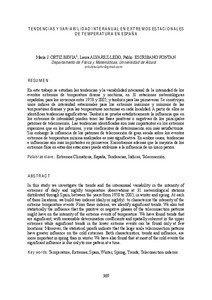Por favor, use este identificador para citar o enlazar este ítem:
http://hdl.handle.net/20.500.11765/8195
Tendencias y variabilidad interanual en extremos estacionales de temperatura en España
Registro completo de metadatos
| Campo DC | Valor | Lengua/Idioma |
|---|---|---|
| dc.contributor.author | Ortiz Bevia, María José | es_ES |
| dc.contributor.author | Álvarez-Ledo, Laura | es_ES |
| dc.contributor.author | Escribano, Pablo | es_ES |
| dc.date.accessioned | 2018-01-08T09:41:00Z | - |
| dc.date.available | 2018-01-08T09:41:00Z | - |
| dc.date.issued | 2014 | - |
| dc.identifier.citation | Fernández Montes, Sonia; Sánchez Rodrigo, Fernando (eds.). Cambio climático y cambio global. Madrid: Asociación Española de Climatología, 2014, p. 369-378 | es_ES |
| dc.identifier.isbn | 978-84-16027-69-9 | - |
| dc.identifier.uri | http://hdl.handle.net/20.500.11765/8195 | - |
| dc.description | Ponencia presentada en: IX Congreso de la Asociación Española de Climatología celebrado en Almería entre el 28 y el 30 de octubre de 2014. | es_ES |
| dc.description.abstract | [ES]En este trabajo se estudian las tendencias y la variabilidad interanual de la intensidad de los eventos extremos de temperatura diurna y nocturna, en 31 estaciones meteorológicas españolas, para los inviernos entre 1958 y 2005, y también para las primaveras. Se construyen unos índices de intensidad estacionales para los extremos máximos y mínimos de las temperaturas diurnas y para las temperaturas nocturnas en cada localidad. A partir de ellos se identifican tendencias significativas. También se prueba estadísticamente la influencia que en los extremos de intensidad pueden tener las fases positivas o negativas de los principales patrones de teleconexión. Las tendencias identificadas son más importantes en los extremos superiores que en los inferiores, y sus coeficientes de determinación son más satisfactorios. Sin embargo la influencia de los patrones de teleconexión de gran escala sobre los eventos extremos de temperatura mínima analizados es más significativa. En ambos casos, tendencias e influencias son más importantes en primavera. Encontramos además que la mayoría de los extremos fríos en estas dos estaciones puede atribuirse a la influencia de un único patrón. | es_ES |
| dc.description.abstract | [EN]In this study we investigate the trends and the interannual variability in the intensity of extremes of daily and nightly temperature observations at 31 meteorological stations distributed through Spain, between the years from 1958 to 2005, in winter and spring. At each of these locations, we build two indexes (daily or nightly) to characterize the intensity of the extreme temperature events. From these indexes, we identify significant trends. We also test statistically the influence that the positive or negative phases of the teleconnection patterns might have on the intensity of the extreme events of temperature. We have found trends that are significant, with reasonable determination coefficients and spatially coherent in the upper extremes while significant trends in the lower extreme events can be found only at few locations. Moreover, the statistical proofs indicate that the large scale teleconnection patterns have greater influence on the cold extremes. Both characteristics, trends and influence, are more important in spring than in winter. We have also found that at most of the cold events the significant influence is due only to one pattern at a time. | es_ES |
| dc.language.iso | spa | es_ES |
| dc.publisher | Asociación Española de Climatología | es_ES |
| dc.relation.ispartof | Publicaciones de la Asociación Española de Climatología. Serie A;9 | - |
| dc.rights | Licencia CC: Reconocimiento CC BY | es_ES |
| dc.subject | Extremos climáticos | es_ES |
| dc.subject | Tendencias | es_ES |
| dc.subject | Índices | es_ES |
| dc.subject | Teleconexión | es_ES |
| dc.subject | Extremes | es_ES |
| dc.subject | Teleconection indexes | es_ES |
| dc.subject | Trends | es_ES |
| dc.title | Tendencias y variabilidad interanual en extremos estacionales de temperatura en España | es_ES |
| dc.type | info:eu-repo/semantics/conferenceObject | es_ES |
| dc.rights.accessRights | info:eu-repo/semantics/openAccess | es_ES |
| Colecciones: | (2014, Almería). IX Congreso AEC | |
Ficheros en este ítem:
| Fichero | Descripción | Tamaño | Formato | ||
|---|---|---|---|---|---|
| 0035_IX-2014-MJ_ORTIZ... | 306,02 kB | Adobe PDF |  Visualizar/Abrir |
Los ítems de Arcimis están protegidos por una Licencia Creative Commons, salvo que se indique lo contrario.





